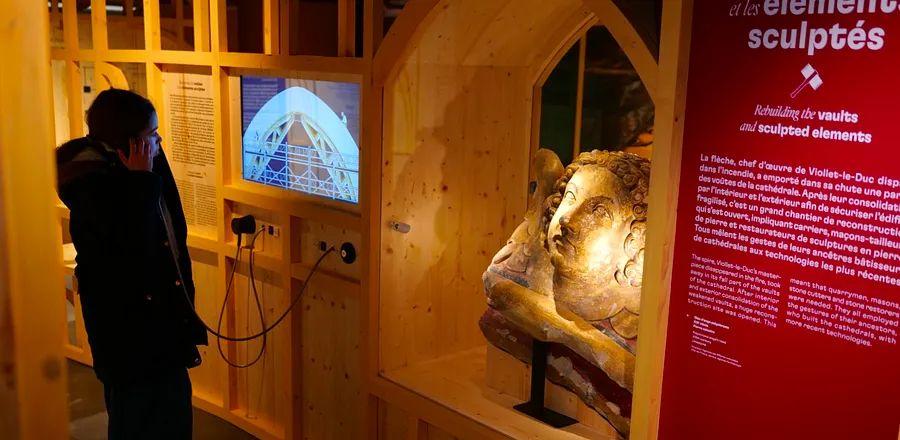New Notre-Dame Exhibit Offers a Behind-the-Scenes Look—And a Journey Beneath the Cathedral—During Its Restoration

Thirteenth-century timber, reduced to ashes in the devastating fire. The cockerel, once gracing the top of the spire, salvaged intact from the debris. The copper statues of the apostles, so close you could almost touch them. These are just a few of the remarkable artifacts showcased in two new exhibits that provide insight into what’s being dubbed the “chantier du siècle” (construction project of the century).
Dominating the Ile de la Cité in the heart of the Seine, Notre-Dame de Paris has witnessed significant historical events: the ceremonial arrival of the Crown of Thorns in France, the French Revolution, and Napoleon’s coronation as emperor. However, none of these moments was as catastrophic as the fire on April 15, 2019. The spire fell, the roof collapsed, and several vaults crumbled, but—thanks to the brave actions of the Paris pompiers—the structure remained intact. An extraordinary response followed: 340,000 individuals from 150 nations contributed €846 million to restore this beloved Gothic masterpiece cherished worldwide.
The restoration initiative is monumental and will not be finished until late 2024. Consider the raw materials: 1,000 cubic meters of stone, 2,000 oak trees sourced from French woodlands, and 3,000 square meters of stained glass. Furthermore, there’s a legion of skilled artisans. From specialized art restorers and carpenters to stone masons and roofers, around 1,000 workers are actively engaged both on-site and in workshops throughout France. These craftsmen are following in the traditions of the great cathedral builders of the Middle Ages who employed innovative construction techniques to awe the world. With their expertise, today's artisans are continuing an ancestral savoir-faire and a time-honored tradition of craftsmanship.
A new cultural venue beneath Notre-Dame
Even while closed, Notre-Dame de Paris exerts a captivating allure. It’s not merely tourists taking selfies in front of the façade; locals pause to grab espresso from a bicycle cart, musicians fill the air with melodies, and visitors observe Europe’s tallest crane (standing at 262 feet) from the stadium-style seating arranged on the parvis, or city square in front of the cathedral. As of March 2023, there’s a new addition to this lively scene—just follow the intriguing staircase leading underground to a fresh cultural venue near rue d’Arcole.
Once a parking garage, this underground space now features Eternal Notre-Dame, a virtual reality experience, along with a complimentary exhibit titled Notre-Dame de Paris: In the Heart of the Restoration.
“With 12 million visitors, Notre-Dame was the most popular monument in Europe before the fire,” shared Lisa Bergugnat, the culture and program director for Rebâtir Notre-Dame de Paris, the public institution focused on preserving and restoring Notre-Dame. “Our aim with this exhibit is to connect with the public who are frustrated by their inability to enter the cathedral, while also providing insights into the restoration project and the various trades involved . . . some of which have roots in antiquity. These trades are actively hiring and need a workforce. The Notre-Dame restoration presents an opportunity to highlight their contributions and elevate their work.”
Take carpentry, for instance. A dedicated display illustrates the meticulous process required to reconstruct the cathedral’s medieval charpente, or timber framing: from the forestry expert selecting an oak tree (some reaching heights of 65 feet) to the sawmill (50 were engaged across France) to the master carpenter’s workshop located in eastern France. Designing the lace-like spire demands exceptional technical skill—the complexity is further amplified by its assembly 315 feet above the ground.
To restore the vaults and sculpted features, the project began in the quarries of Oise and Aisne to source stone that closely resembles the original. Quarried blocks were cut and shaped by masons in their workshops, then transported to the site for assembly to replace and reinforce the vaults.
The restoration of the grand organ—the largest in France, featuring 8,000 pipes, 19 wind chests, and 115 organ stops—is remarkably intricate. Although the organ was unharmed in the fire, it was coated in lead dust. It was entirely taken apart and cleaned by specialized organ artisans known as facteurs d’orgue, working in three different workshops across France. "Once the organ is reinstalled in the cathedral, it will require six months of tuning," Bergugnat explained. "They will work at night because complete silence is necessary for the job."
The most remarkable piece on display? "[The sculpted angel head] that fell 33 meters when the spire collapsed," Bergugnat noted. "It won't be restored because it was damaged, but when you see it beautifully lit like this, you wouldn't guess it experienced such a dramatic fall."
The exhibit also features a detailed model replica of Notre-Dame and a film that outlines the construction process. That charred piece of wood? Interestingly, the restoration has involved preserving every single remnant—regardless of damage—for scientific study. This approach has led archaeologists to new findings, such as the discovery of iron reinforcements within the original stonework, marking Notre-Dame as the world’s first Gothic cathedral to utilize such building techniques.

Courtesy of David Bordes / Etablissement public chargé de la conservation et de la restauration de la cathédrale Notre-Dame de Paris
Viollet-le-Duc’s tribute to French heritage
The original construction, along with the extensive restoration in the 19th century, takes center stage at the Cité de l’architecture et du patrimoine with the exhibit Notre-Dame de Paris: From Builders to Restorers. Housed in the Palais de Chaillot, the museum offers stunning views of the Eiffel Tower through expansive windows as you stroll through its permanent collection, which features a gallery of plaster casts celebrating a thousand years of French architectural history. Founded by Eugène Viollet-le-Duc, the renowned 19th-century architect known for rescuing several of France’s iconic medieval structures (including Carcassonne and Mont-Saint-Michel), the museum honors his legacy. The gargoyles and spire that grace Notre-Dame were decorative additions made by Viollet-le-Duc during his efforts to restore the cathedral after years of deterioration and neglect.
"Our collaboration with the Cité de l’architecture et du patrimoine on this exhibit stems from our shared mission to honor French heritage, and our connection to Viollet-le-Duc," Bergugnat explained. "Additionally, the museum’s inaugural director, Geoffroy-Dechaume, sculpted the statues that adorn the spire."
The standout features of the exhibit are undoubtedly the stunning statues of the apostles and the evangelists, crafted from hammered copper leaf in 1857. Remarkably, these statues were removed for restoration just four days before the fire, sparing them from destruction. The intricate details are striking: a bearded Saint Philip bears a cross, Saint Peter holds a key, and the martyr Saint Bartholomew, who was flayed alive and beheaded by pagans, clutches a knife. Notably, Saint Thomas, the patron saint of architects, bears the likeness of Viollet-le-Duc, with his staff engraved with the architect’s name.
Before long, the statues will be returned to their watchful positions atop the spire overlooking the city. "You won't have another opportunity to view them up close like this," Bergugnat remarked.

Courtesy of David Bordes / Etablissement public chargé de la conservation et de la restauration de la cathédrale Notre-Dame de Paris
Visiting Details for Each Exhibit
The exhibit Notre-Dame de Paris: In the Heart of the Restoration is being showcased in a newly established cultural space beneath the cathedral until Notre-Dame reopens at the end of 2024, and entry is free.
The Notre-Dame de Paris: From Builders to Restorers exhibit will be available until April 29, 2024, at the Cité de l’architecture & du patrimoine (1, place du Trocadéro et du 11 Novembre). The museum is open from 11 a.m. to 7 p.m., but closed on Tuesdays. The standard admission fee is €9.

1

2

3

4

5
Evaluation :
5/5